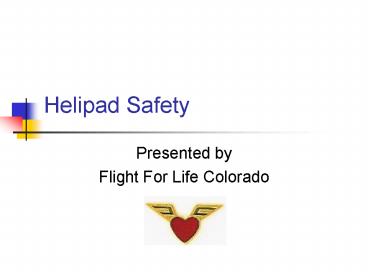Helipad Safety - PowerPoint PPT Presentation
1 / 12
Title:
Helipad Safety
Description:
Allow flight crew to operate stretcher system. Position cart in proper position, setting brake. Wait for signal from flight crew to remove stretcher. ... – PowerPoint PPT presentation
Number of Views:804
Avg rating:3.0/5.0
Title: Helipad Safety
1
Helipad Safety
- Presented by
- Flight For Life Colorado
2
Objectives
- To provide initial and recurrent helipad safety
training for hospital staff. - To familiarize all staff with helicopter
operations on the helipad. - To review helipad safety systems.
- To insure that patient loading and off-loading
are performed safely and efficiently.
3
Who should receive helipad safety training?
- All hospital staff with a responsibility to
respond to the helipad - Patient care staff
- Hospital security officers
- Plant operations/maintenance staff
- All staff should receive initial and annual
refresher training. - Track training on rosters.
4
Basics of helipad safety
- Remain alert at all times.
- Restrict access to those with current helipad
safety training. - Be aware of any changes in helipad surroundings.
- Wait for signal from flight crew to approach the
aircraft. - Always remain in view of the crew.
5
Daily helipad inspection
- Clear or secure all loose objects.
- Remove snow / ice
- Use only non-corrosive ice melter.
- Check all navigational aids
- Windsock, beacon, perimeter and flood lights.
- Inspect surrounding area for new hazards
- Cranes, new construction, birds, etc.
- Check fire suppression systems and escapes.
6
Before the aircraft arrives
- Insure helipad is clear
- Rocks, trash, carts, cords.
- Debris can injure staff or damage aircraft.
- Keep all staff in protected area
- Inside building or behind structures.
- Rotor wash can be hazardous.
- Secure all loose clothing, caps, scarves, etc.
- Implement universal precautions, as appropriate.
- On ground level helipads, restrict pedestrian
and/or vehicle traffic.
7
Aircraft arrival
- At night, keep flood lights off until aircraft
has landed. - Remain in protected location until helicopter
rotor blades have stopped. - Watch for signal from the flight crew to
approach. - Always walk while on the helipad.
- Use caution when surface is slippery.
- Allow flight crew to open and close doors.
- Follow flight crews instructions during
off-loading.
8
Hot off-loading
- Comm Center will advise you if Flight For Life
has requested a hot offload (with rotor blades
turning). - Secure all loose clothing, caps, scarves,
stethoscopes. - Use eye and ear protection.
- Remain in protected area until signaled to
approach by flight crew. - Allow flight crew to operate all doors.
9
Hot off-loading - contd.
- Approach from within view of pilot.
- Keep head low when walking under rotor blades,
especially when windy. - Keep hands at shoulder level.
- Avoid lifting anything into rotor blades.
- Never go behind cabin area or rear of skids!
- Extreme danger from spinning tail rotor.
10
Patient off-loading
- Allow flight crew to operate stretcher system.
- Position cart in proper position, setting brake.
- Wait for signal from flight crew to remove
stretcher. - Watch for tension on IV lines, oxygen tubing,
monitoring cables. - Assist flight crew with patient care, as needed.
11
Additional points
- Be familiar with your helipad systems
- Fire suppression and escape.
- Communications.
- Lighting.
- Request specific training with helicopter
services that frequent your facility.
12
Flight For Life Colorado
- Eurocopter AS-350 B3 A-Star
- Single patient, loaded into left side of cabin.
- Shut down requires approximately 30-60 sec.
- Tail rotor on right side of tail boom.































